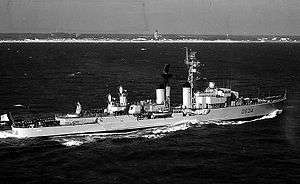French destroyer Jauréguiberry (D637)
 Bouvet, sister ship of Jauréguiberry, in 1965 | |
| History | |
|---|---|
| Name: | Jauréguiberry |
| Namesake: | Bernard Jauréguiberry |
| Laid down: | September 1954 |
| Launched: | 5 November 1955 |
| Commissioned: | 15 July 1958 |
| Decommissioned: | 16 September 1977 |
| Struck: | 30 May 1986 |
| Homeport: | Brest |
| Identification: | D 637 |
| Fate: | Sunk as the target ship Q580 for the experimentation of the Exocet missile. |
| General characteristics | |
| Class and type: | T 53-class destroyer |
| Displacement: |
|
| Length: | 128.6 m (422 ft) |
| Beam: | 12.7 m (42 ft) |
| Draught: | 5.4 m (18 ft) |
| Propulsion: | 2 shaft geared turbines, 4 boilers, 63,000 hp (46,979 kW) |
| Speed: | 34 knots (63 km/h; 39 mph) |
| Range: | 5,000 nmi (9,300 km; 5,800 mi) at 18 knots (33 km/h; 21 mph) |
| Complement: | 347 |
| Armament: |
|
The fleet escort Jauréguiberry was a French destroyer of the T 53 class, designed for anti-air and (to a lesser extent) anti-submarine roles. She was the second French Navy vessel to bear the name.
Laid down in September 1954, the vessel was launched on 5 November 1955. Jauréguiberry was commissioned into the Marine Nationale on 15 July 1958 with the identification number D 637.
Service history
In 1966 and 1968, she was involved in two nuclear tests with "Force Alfa", and a third one in 1970 with the cruiser De Grasse, in the Pacific Ocean. In 1974, she achieved a long mission with the frigate Duquesne.
In the beginning of 1977, a few months before being decommissioned, she was used for the film "Le Crabe-Tambour" by Pierre Schoendoerffer. The ship was decommissioned 16 September 1977 and struck from the vessel registry 30 May 1986.
Sources and references
- (in French) Escorteur d'Escadre Jauréguiberry, netmarine.net